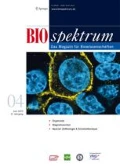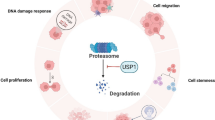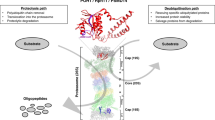Abstract
Proteases not only play an essential role in biological processes, they serve as clinically approved targets of current oncological approaches. As such, Taspase1 was postulated as therapeutic target in leukemogenesis. However, our molecular knowledge on its function is still rather fragmentary as still no effective inhibitors are available. Moreover the Taspase1 degradome, the collectivity of its target proteins, could be revealed just recently by the development of special cell-based assays.
Similar content being viewed by others
Literatur
Turk B (2006) Targeting proteases: successes, failures and future prospects. Nat Rev Drug Discov 5:785–799
Hsieh JJ, Cheng EH, Korsmeyer SJ (2003) Taspase1: a threonine aspartase required for cleavage of MLL and proper HOX gene expression. Cell 115:293–303
Zhou H, Spicuglia S, Hsieh JJ et al. (2006) Uncleaved TFIIA is a substrate for taspase 1 and active in transcription. Mol Cell Biol 26:2728–2735
Bier C, Knauer SK, Klapthor A et al. (2011) Cell-based analysis of structure-function activity of threonine aspartase 1. J Biol Chem 286:3007–3017
Knauer SK, Fetz V, Rabenstein J et al. (2011) Bioassays to monitor Taspase1 function for the identification of pharmacogenetic inhibitors. PLoS One 6:e18253
Bier C, Knauer SK, Docter D et al. (2011) The importin-alpha/nucleophosmin switch controls taspase1 protease function. Traffic 12:703–714
Bier C, Hecht R, Kunst L et al. (2012) Overexpression of the catalytically impaired Taspase1 T234V or Taspase1 D233A variants does not have a dominant negative effect in T(4;11) leukemia cells. PLoS One 7:e34142
Bier C, Knauer SK, Wunsch D et al. (2012) Allosteric inhibition of Taspase1’s pathobiological activity by enforced dimerization in vivo. FASEB J 26:3421–3429
Author information
Authors and Affiliations
Corresponding authors
Additional information
Roland H. Stauber Jahrgang 1963. 1983–1989 Biologiestudium an der Universität Würzburg. 1989–1994 Promotion an der Universität Würzburg. 1994–1997 Postdoktorand am National Cancer Institute in Bethesda, MD, USA. 1997–2001 Gruppenleiter am Institut für Virologie der Universität Erlangen. 1999 Habilitation. 2001–2006 Gruppenleiter am Georg-Speyer-Haus in Frankfurt a. M. Seit 2006 Professor an der Universitätsmedizin Mainz.
Shirley K. Knauer Jahrgang 1976. 1995–2000 Biologiestudium an der Universität Erlangen. 2005 Promotion an der Universität Frankfurt a. M. 2005–2006 Postdoktorandin am Georg-Speyer-Haus in Frankfurt a. M. 2007–2009 Junior-Gruppenleiterin an der Universitätsmedizin Mainz. 2008 Habilitation. Seit 2010 Junior-Professorin am Zentrum für Medizinische Biotechnologie der Universität Duisburg-Essen.
Rights and permissions
About this article
Cite this article
Stauber, R.H., Knauer, S.K. Taspase1 — Lizenz zum Schneiden. Biospektrum 19, 134–136 (2013). https://doi.org/10.1007/s12268-013-0281-5
Published:
Issue Date:
DOI: https://doi.org/10.1007/s12268-013-0281-5




